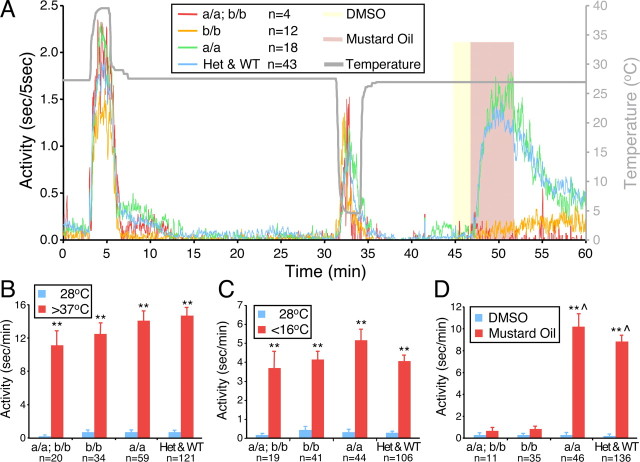Figure 3.
Zebrafish TRPA1 paralogs are required for normal behavioral responses to mustard oil but not to noxious temperatures. A, Each data point represents the average duration of locomotor activity every 5 s for the indicated number of larvae of each genotype. The gray line and right axis indicate water temperature. Yellow and red shading indicate exposure of larvae to 1% DMSO and 100 μm mustard oil in 1% DMSO, respectively. Larvae were obtained by mating trpa1a+/−; trpa1b+/− adults. a/a; b/b represents trpa1a−/−; trpa1b−/− larvae. b/b represents trpa1a+/+; trpa1b−/− and trpa1a+/−; trpa1b−/− larvae. a/a represents trpa1a−/−; trpa1b+/+ and trpa1a−/−; trpa1b+/− larvae. Het & WT represents all other genotypes. B–D, Combined results from three independent experiments for each condition are shown. Each bar represents the average seconds of locomotor activity per minute ± SEM. Blue bars represent locomotor activity during 2 min before temperature change (B, C) or during exposure to 1% DMSO (D). The locomotor activity of larvae of all genotypes dramatically increased after exposure to noxious heat (>37°C) (A, B) or noxious cold (<16°C) (A, C). Temperatures between 4 and 16°C had similar stimulatory effects on locomotor activity (data not shown). DMSO alone had no effect on locomotor activity (A, D). Mustard oil dramatically increased locomotor activity of larvae of all genotypes except those homozygous mutant for trpa1b or doubly homozygous mutant for trpa1a and trpa1b (A, D). **p < 0.01 for 28°C versus >37°C, 28°C versus <16°C, and DMSO versus mustard oil; ⋀p < 0.01 for mustard oil versus b/b mustard oil or versus a/a; b/b mustard oil, all by two-tailed Student's t test.

